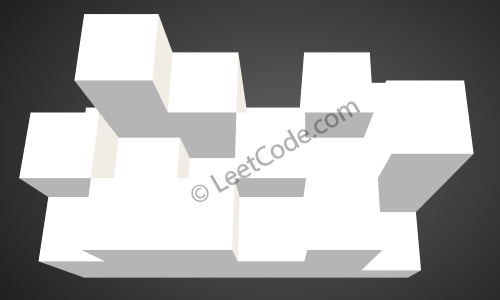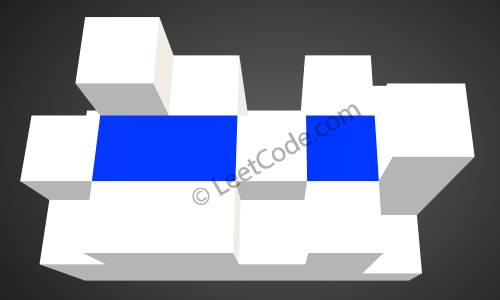问题描述:
Given an m x n matrix of positive integers representing the height of each unit cell in a 2D elevation map, compute the volume of water it is able to trap after raining.
Note:
Both m and n are less than 110. The height of each unit cell is greater than 0 and is less than 20,000.
Example:
Given the following 3x6 height map: [ [1,4,3,1,3,2], [3,2,1,3,2,4], [2,3,3,2,3,1] ] Return 4.

The above image represents the elevation map [[1,4,3,1,3,2],[3,2,1,3,2,4],[2,3,3,2,3,1]] before the rain.

After the rain, water is trapped between the blocks. The total volume of water trapped is 4.
解题思路:
类比于trapped rain water, 上一个是一维的数组,而这一个是二维的矩阵。
所以其可能的情况就会比一维数组更为复杂
一开始可能会想,对该格子所在的行和列找边界比较,但实际上这种想法是错误的
如图所示:

对于8所在的格子,如果只看所在的行和列的话,边界为13, 看起来能盛(13-8)的水,但是实际上,这些水都会从虚线所指方向流走。
所以我们要找边界,应该是从整个矩阵的外围找边界。
所以我们可以使用最小堆(priority_queue)来解决这个问题,同时用一个二维矩阵记录是否访问过
首先把外围的一圈放进堆里,然后取出最小的,尝试上下左右四个方向走,找到未访问过的点,然后访问它,并比较它与当前最大值的墙的高度
然后将这一点标记为访问同时将其压到堆里
代码:
class Solution { public: int trapRainWater(vector<vector<int>>& heightMap) { if(heightMap.empty()) return 0; int m = heightMap.size(); int n = heightMap[0].size(); int ret = 0; int mx = INT_MIN; priority_queue<pair<int, int>, vector<pair<int, int>>, greater<pair<int,int>>> q; vector<vector<bool>> visited(m, vector<bool>(n, false)); vector<vector<int>> dir{{0, -1}, {-1, 0}, {0, 1}, {1, 0}}; for(int i =0; i < m; i++){ for(int j = 0; j < n; j++){ if(i == 0 || j == 0 || i == m-1 || j == n-1){ q.push({heightMap[i][j], i*n + j}); visited[i][j] = true; } } } while(!q.empty()){ auto t = q.top(); q.pop(); int h = t.first; int r = t.second / n; int c = t.second % n; mx = max(h, mx); for(int i = 0; i < dir.size(); i++){ int x = r + dir[i][0]; int y = c + dir[i][1]; if(x < 0 || x >= m || y < 0 || y >= n || visited[x][y]) continue; visited[x][y] = true; if(heightMap[x][y] < mx) ret += (mx - heightMap[x][y]); q.push({heightMap[x][y], x * n + y}); } } return ret; } };
参考:
http://www.cnblogs.com/grandyang/p/5928987.html
c++: pair
c++: greater
c++: priority_queue